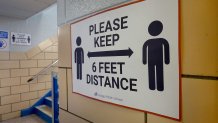June 15, 2021, marked the full reopening of California – including San Diego County – which means the state’s color-coded, tiered system was scrapped and pandemic-era restrictions were changed. As we begin to ease ourselves back into a life more closely resembling pre-COVID, here’s a look at what you need to know about life after the big June 15 reopening.
Hello, Full Capacity
According to the California Department of Public Health, all business sectors across the state listed in the Blueprint for a Safer Economy chart can return to “usual operations” – except for mega events, which we will get into a little later (or you can read about here).
Get top local stories in San Diego delivered to you every morning. Sign up for NBC San Diego's News Headlines newsletter.
That means indoors and outdoors, San Diego County places like restaurants, museums, breweries, bars, movie theaters, gyms, and more can go back to running at full capacity.
This really ramps up business for many of these sectors, as most had been operating at capacity restrictions between 25% (bars) to 50% (restaurants, movie theaters, gyms) under the yellow tier.
Last week, as San Diego County moved into the yellow tier for its final 6 days before the big June 15 full reopening, Supervisor Nathan Fletcher said the county was nearing its goal of getting at least 75% of the eligible population in San Diego County vaccinated with at least one dose of the COVID-19 vaccine.
“One of the reasons we’re in the position we’re in on cases and hospitalizations is because of the incredible work of San Diegans getting vaccinated," Fletcher said.
But, while full capacity returns this week, San Diego County Public Health Officer Dr. Wilma Wooten said last week that locals should remember “the pandemic is not over.”
She had this to say about June 15:
“June 15 is not the magic date or bullet for declaring the pandemic is over,” Wooten noted. “We are still seeing cases but things are slowing down, and that’s what’s important.”
Wooten said San Diego County would continue to follow the state's ongoing state of emergency declaration.
“We need to get to a point where we have no cases for at least two incubation periods, and if that happens sooner than the end of the year, that’s another thing," Wooten said. "But the state will continue with [an emergency declaration] through the end of the year.”
Fletcher agreed with keeping the county following California’s emergency declaration, saying the state is still working its way out of the pandemic.
“But June 15, San Diego County, we will align with the state. The tiers will be gone,” he added.
So, What About Those Face Masks?
"Face coverings," "face masks" (there are other kinds of masks?), "face shields," "gators," "N95 masks," "PPE" -- soon after the pandemic hit in 2020, San Diegans were also slapped with a sometimes bewildering array of options to prevent the spread of the novel coronavirus.
When the dust settled (beg pardon), one thing was agreed upon in scientific circles: The most effective way to prevent the spread of the disease was covering your nose and mouth and, in some quarters, that meant covering it twice, with a paper AND a cloth mask.
For a while -- and in some quarters, to this day (think: airlines) -- gators, those fabric tubes you wore around your neck and pulled up to filter your respiratory system, were out of vogue. Masks, though, never lost their COVID luster. They prevented the spread of the disease, saving untold lives. After June 15, though, the onus is on the UN-vaccinated.

On that date, San Diego County will follow the state's guidance on face coverings, with California's Beyond the Blueprint for industry and business sectors aligning with the guidelines established by the Centers for Disease Control and Prevention.
OK, so that wasn't short, nor was it particularly informative. What are the officials trying to say?
San Diegans will have to wear a mask when:
- They are not vaccinated and are at an indoor public setting (retail, restaurants, theaters, family entertainment centers, meetings, state and local government offices serving the public)
- On public transit (planes, trains and automobiles)
- Indoors at K-12 schools and other child-care and youth settings
- In health-care settings
- In jails and prisons
- In homeless shelters
Of course, all the old exceptions still apply for kids under 2, people with relevant medical conditions, the hearing impaired, etc.
That said, businesses will still have the right to require patrons to wear masks and can check for proof of coronavirus vaccination. Or they can simply tell people they're welcome if they self-attest to being vaccinated.
So get ready for facial recognition -- many but not most places are likely to drop the mask mandate, though it depends, too, on what OSHA says. Officials there decided last week that workers could only go maskless if every employee in a room is fully vaccinated against the coronavirus. On Wednesday night CAL OSHA met again and withdrew this workplace rule, saying it would consider the issue at its June 17 meeting and potentially have them go into effect by month’s end.
So while you may be ordering a cocktail without your mask on, your bartender may very well be wearing one when they pour you that drink you've waited 16 months for.
Bye, Social Distance
On Tuesday, June 15, every misanthrope's favorite guideline, social distancing, will go quietly into the night, except for folks who self-identify as unvaccinated, are attending schools, healthcare setting and a few other locations.
For most of the pandemic, most of us in public have been keeping six feet apart, unless separated by a barrier of some sort -- usually plexiglass. Then, in March of this year, that benchmark at schools was reduced to three feet, permitting schools to more easily reopen after educators had been vaccinated.

Once again consulting our trusty friend, California's Beyond the Blueprint for Industry and Business Sectors guidelines, we learn that there are no restrictions whatsoever for attendees, customers and guests.
NBC 7 spoke to representatives of a few school districts, who said that kids would still need to be kept at arm's length:
"We’ll follow CDPH guidelines as they evolve, but for summer, we’ll keep in place the distancing guidelines currently in place - generally five to six feet of distancing," Richard Barrera, San Diego Unified's school board president, told us. "Will probably be relaxed in the fall."
"The Sweetwater district plans to follow guidelines provided by the state when we fully reopen in July, as we have during our partial reopening earlier this year," a representative for the Sweetwater Union High School District.
For the most part, though, you'll be saying goodbye o those ever-present stickers, lines of tape and spray-painted markers on the ground that, if we're honest, were mere recommendations often squeezed by everyone but the most vigilant.
Now we can only hope that people have gone back to regularly showering.
What About Mega Events?
California defines a mega event as any event that draws 5,000 or more people indoors or 10,000 or more people outdoors. The most common type of mega events are sporting events, concerts, festivals, conventions and fairs.
Mega events are considered high-risk because of their wide appeal and large draw, meaning people from across the country -- and in some cases the world -- will want to attend. While at the event, people will inevitably gather in large crowds and be in close proximity to hundreds if not thousands of people, the state says.
There are two types of mega events: indoor events, like conventions, conferences, sporting events and concerts; and outdoor events, like music or food festivals, car shows, parades, outdoor concerts and more.
It is required that all attendees at indoor mega events show proof they are fully vaccinated or must have a negative COVID-19 test. It is up to the event to make those requirements clear to attendees.
It is only strongly recommended that outdoor mega events do the same. It will be up to event organizers to decide whether or not they will instill the requirement.
In addition, attendees at both indoor and outdoor events must wear face coverings based on current CDPH standards, which makes recommendations based on vaccination status. For those fully vaccinated, you can take off that face mask. For those who are not, a face covering is required.
You can dive deeper into the rules surrounding mega events here.
San Diego County's Coronavirus Vaccinations
According to San Diego County’s online vaccination dashboard, more than 75% of eligible San Diegans age 12 and over had received at least one dose of the COVID-19 vaccine as of June 15, 2021.
That stat – which equals 2,107,447 San Diego County residents who have gotten at least one dose of the coronavirus vaccine – surpasses the goal the county had set for the region, which was to have 2,101,936 San Diegans vaccinated with at least one dose.
According to the county’s dashboard, a total of 1,749,978 San Diego residents were fully vaccinated with both doses of the COVID-19 vaccine as of June 14, 2021.
The ramped-up local vaccination rates coupled with a decrease in coronavirus cases have kept San Diego County on track toward California’s June 15 reopening.
County and local partners have been working to keep the momentum going; over the weekend, the San Diego Padres hosted a pop-up vaccine clinic and the doses came with a reward: two free tickets to a Padres game.
California Gov. Gavin Newsom and the state public health department have also been running the “Vax for the Win” lottery, awarding prizes – at random – to Californians who are vaccinated, including a few lucky winners in San Diego County.



